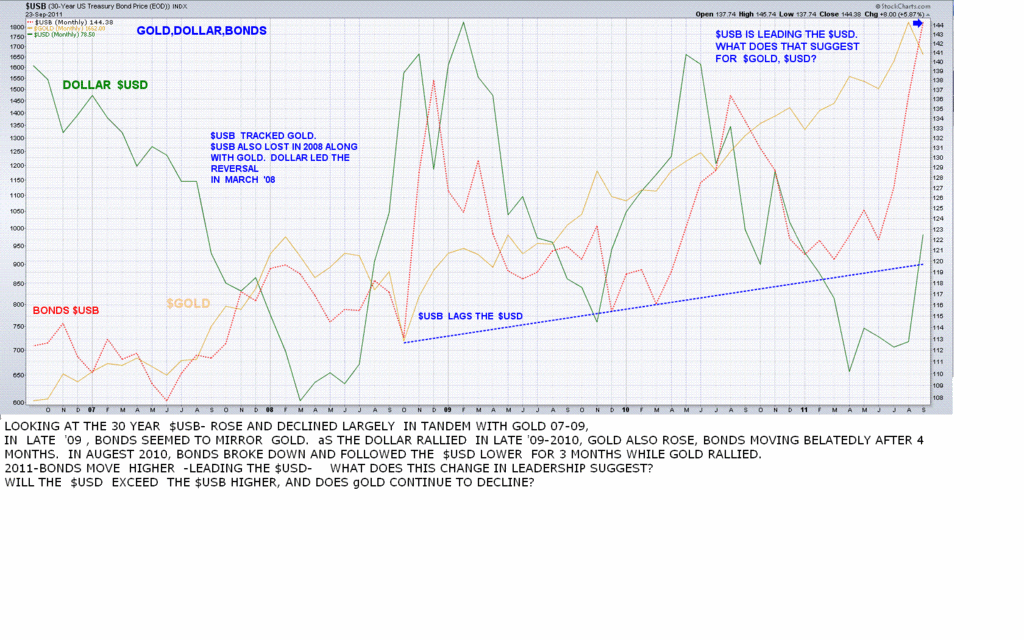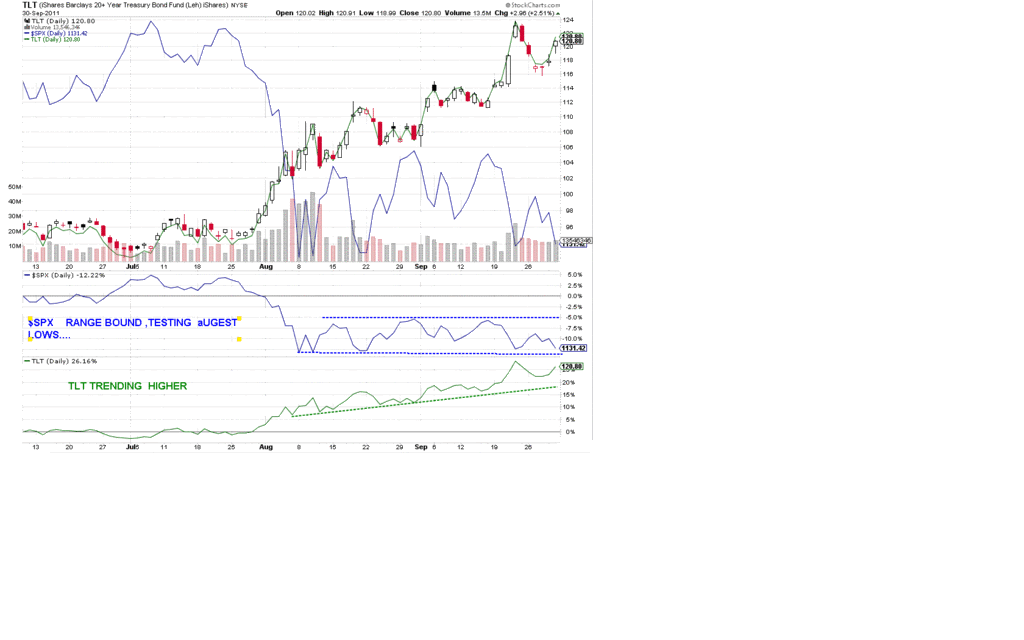|
|
Post by sd on Sept 23, 2011 9:41:21 GMT -5
I don't think we're at a bottom, there are too many issues-
Maybe it will be earnings and reduced forecasts for growth that will put the final push down to significant lower support? .
The rise of the dollar is what's attributed to why Gold has not been the safe haven-go to trade by the market. I did go back into DZZ today- I have been loathe to see a winning trade roll over and so I don't give it much leeway.
I think it's prudent to cover some specific shorts the way you did - Lock in some profits along the way. It was just a few weeks ago we had 500 point rallies, and 600 point sell-offs.
ZROZ- That was a big 2 day move! Why? I don't know- Flight from Gold contribute? Gold - I see Gold is still within the weekly channel- With first support at $150 -(GLD). Where do you go to hide if the market tanks further? And if we are in a year(s) long recession? Good Luck,SD
|
|
|
|
Post by dg on Sept 23, 2011 16:55:24 GMT -5
If I had some money burning a hole in my pocket, I would take this as an opportunity to add more gold and silver (metal, not paper) to my holdings.
|
|
|
|
Post by sd on Sept 23, 2011 18:50:25 GMT -5
If I had some money burning a hole in my pocket, I would take this as an opportunity to add more gold and silver (metal, not paper) to my holdings.
I would agree- I think this is getting close to the point where Gold will likely find it's feet ($150 range) -This next week- see how it behaves.
I've sniffed the air here several times, and unfortunately I don't detect anything smoldering -in the pants or shirt unfortunately. LOL!
|
|
|
|
Post by dg on Sept 24, 2011 15:47:44 GMT -5
$150 range? metallic gold is priced over $1600 per ounce.
|
|
|
|
Post by sd on Sept 24, 2011 20:10:36 GMT -5
Sorry,
Was referring to the ETF -GLD!
|
|
|
|
Post by sd on Sept 25, 2011 10:15:27 GMT -5
Was trying to raise my awareness of the interaction between the market , Gold, and the Dollar. There's not always an exact correllation between the 3 over the past 5 year period, but dollar reversals from a low and a market peak sure does look exactly like 2007. The dollar reversals & market peaks at significant extremes mark each other well. Gold not as much, and in one period, we had a rising dollar, rising MKT, and rising Gold- Maybe it's an issue of the dollar getting too strong? or of extremes between the mkt & dollar? note in 2008 the rising dollar gave was matched by a Mkt that tanked and Gold decling- Very similar to the present day charts with the dollar coming off a significant low, as the mkt turned.  |
|
|
|
Post by sd on Sept 25, 2011 12:06:29 GMT -5
CHART COMPARING $USD,$USB,gOLD  |
|
|
|
Post by blygh on Oct 1, 2011 9:09:37 GMT -5
Well unlike 2007, we are not getting the double top (July and early October 2007),
perhaps the European baking, PIIGS crisis is limiting the upside. In 2007, the
smart money was getting out of real estate, recognizing thst it was a bubble (this
was after a 239% rise from 2003-2007). Is gold and precious metal the 2011 bubble
that has risen so much and is now starting to pop? The stimulus route is being
abandoned in favor of austerity. No good for the bulls. The west is no longer
net benefitting from cheap Chinese goods - I expect the PIIGS will adopt
restrictive trade policies with China and other emerging markets (BRIC funds now
down 25% since the July high) The Hang Sang has gone from near 27000 to near 18000.
I just don't see where growth is going to come from. People want money more than
they want stuff.
|
|
|
|
Post by bankedout on Oct 1, 2011 20:11:35 GMT -5
That makes sense. I'm thinking about doubling down on my short position. I will probably do so on any further weakness in prices.
|
|
ira85
New Member
Posts: 837
|
Post by ira85 on Oct 2, 2011 16:02:33 GMT -5
Another issue to compare with 2007-08 and now is the action in long bonds.
When the S&P downgraded U. S. debt in August 2011, I completely misjudged what would happen in the credit markets. I thought it would weaken treasury bonds and interest rates would rise. Boy was that ever wrong. Both long and short dated U. S. Treasuries have seen rates fall to record lows. 20-year Treasuries (TLT) have shot up in price. Long U.S. bonds have been a leading asset class since the turmoil started in August. A long term graph of TLT shows a parabolic rise since August, much like late 2008.
Why would investors buy long U.S. Treasuries? Because they want to lock in 2% annual interest rates for the next 20 years? Obviously not. Two possibilities occur to me. First, it could be a momentum play. Just herd mentality. It’s rising, so buy more and ride the wave up. Just a mindless stampede into a bubble. But what if there’s logic to it? What logical reason could there be for buying bonds that are selling at record low interest rates? If interest rates turn even modestly higher, as would happen if we had some economic recovery, anyone who buys bonds now would face a capital loss. What’s the potential for gain? If we are entering a new recession and a global bear market, interest rates could fall even further. And at low levels, even small interest rate drops can result in big capital gains for bonds. A drop from 2% to 1.5% is a 25% capital gain.
So my fear is the rise in long bonds is logical. It’s a sign investors are expecting rates to fall even further. And the reason rates would fall is if the economy and stock markets are going to fall further. With copper hitting new lows, markets worldwide falling, and the Economic Cycle Research Institute forecasting a recession, it looks like the trading range the S&P 500 has been in the last 3 months will break out to the downside in the near future. I bought SDD and SDS last week. It looks increasingly ugly.
But one thing to keep in mind, the market is a leading indicator. Interest rates and the stock market should turn up before we can see clear evidence of recovery. So I’ll be watching TLT for signs it’s rolling over. But until then, I’ll expect the bear to be in charge and the short side to be more profitable. - ira
|
|
|
|
Post by sd on Oct 2, 2011 17:26:32 GMT -5
Good points made in the prior posts. this week could see a retest of the augest lows- Ira's points on the TLT chart- picture tells the story.  |
|
|
|
Post by blygh on Oct 5, 2011 20:26:40 GMT -5
What would a believer in Boomernomics (like me) say. If the expected life span after 65 is 27 years - retirees are trying to avoid the stress of market volatility -wealth preservation rather than growth preservation seems to be a higher consideration - Government bonds avoid the stress
|
|
|
|
Post by sd on Oct 5, 2011 20:54:41 GMT -5
As we get older -Circa 1950 for myself-
preservation of the existing status quo- vs evolutionary gain (momentum gain?) easily becomes a desired result when undue Risk could destroy the small gains the prior 10 years have delivered. They say 5 years is the span horizon
Risk reduction is indeed a prudent strategy as one realizes there is less time ahead for the market to average out the nominal average return.
Bond funds are the focus in the IRA these days. It's just as much about losing less than thinking one might gain more-
Doesn';t build a lot of confidence necessarily, but in the short term, it's a good defensive strategy while volatility is high.
Sd
|
|
|
|
Post by blygh on Oct 8, 2011 8:55:18 GMT -5
From the Times
"The Japanese central bank sounded the alarm over the risks facing the world economy, even as it left its monetary policy unchanged Friday, underscoring the gravity of a global economic slowdown over which policy makers may have little control."
One more reason to stay short- I posted a comment on the WSJ about a story on what a bear market was. The gist of it was that so many sectors are trending downward, industrials, financials, transports, technology, mining, shipping, railroads, steel, precious metals, capital equipment, . . . Unless you can pick a bottom or single out individual stocks, the only rational thing to do is stay out or stay short. You can always get in later if the trend starts rising. The motto of the Rothschild's was "Get in too late and get out too soon" As for picking individual stocks, 50% of a stocks change in value is attributable to the sector it is in. If a sector is heading down, you have at least a 50% probability of losing money on any individual stock. Look at CLF - PE ratio 5, 5 star rating - very bullish is the analysts' consensus - down 45% from a peak of 100 (and a PE of 11).
|
|
|
|
Post by sd on Oct 8, 2011 17:04:10 GMT -5
Agreed- one ideally should take advantage of staying with the trend. Or knowing where one's trade is directionally positioned in the larger time frames. Any trades against that trend need to be done nimbly. Nip profits , reduce losses I'll stick this weekly chart of SDS here as well as under my thread. Chart in this example shows how trading with the trend pays off over time.  |
|